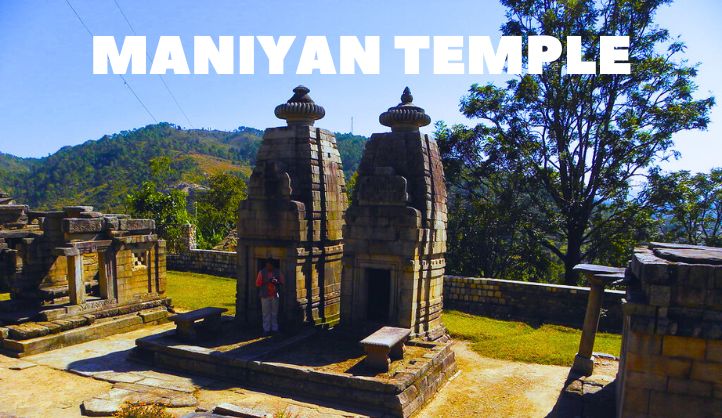Nestled amidst the picturesque Kumaon Hills of Uttarakhand, the Maniyan Temple complex stands as a testament to the region’s rich history and vibrant spiritual heritage. Dedicated to Goddess Durga, the fierce and protective form of Parvati, this ancient temple group offers a captivating glimpse into the architectural prowess and artistic sensibilities of bygone eras.
A Journey Through Time – Unveiling the Maniyan Temple’s History
The exact origins of the Maniyan Temple remain shrouded in the mists of time. Local legends attribute its construction to the Katyuri Kings, a powerful dynasty that ruled the Kumaon region from the 7th to the 12th centuries AD. Historical evidence suggests the temple complex might have been built even earlier, with estimations placing its foundation anywhere between the 6th and 8th centuries AD.
The intricate carvings and architectural style of the temples bear a resemblance to the Katyuri-era architecture seen in other prominent temples of the region, like the Baijnath Temple and the Katarmal Sun Temple. This similarity strengthens the argument for the temple’s association with the Katyuri lineage.
Over the centuries, the Maniyan Temple group witnessed the rise and fall of empires, silently observing the changing landscape of the Kumaon region. It endured the ravages of time and the elements, standing tall as a beacon of faith for generations of devotees. Today, the temple complex is protected by the Archaeological Survey of India (ASI), ensuring its preservation for future generations.
Exploring the Architectural Marvels of the Maniyan Temple Complex
The Maniyan Temple complex is not a singular structure but a fascinating collection of temples dedicated to various deities. The central shrine, dedicated to Goddess Durga, is the most prominent structure. Built in the Nagara style of architecture, it features a shikhara (tower) that tapers towards the top, adorned with intricate carvings depicting mythological scenes and floral motifs. The sanctum sanctorum houses a beautifully crafted idol of Goddess Durga, depicted in her eight-armed form, mounted on a lion.
Surrounding the central shrine are several smaller temples dedicated to other Hindu deities like Shiva, Vishnu, Ganesha, and Surya. Each temple boasts its own unique architectural style and artistic elements. The intricate carvings on the doorways, pillars, and walls showcase the exceptional craftsmanship of the bygone era.
The complex also houses several ornately carved stone mandapas (pavilions). These mandapas were likely used for religious gatherings and ceremonies. The serene atmosphere of the temple complex, accentuated by the surrounding hills and lush greenery, provides a perfect setting for prayer, meditation, and spiritual contemplation.
The Significance of the Maniyan Temple in the Local Culture
The Maniyan Temple holds immense significance in the cultural and religious life of the Kumaon region. It is considered a sacred pilgrimage site, attracting devotees from far and wide. During festivals like Durga Puja and Navratri, the temple comes alive with vibrant celebrations. Devotees offer prayers to Goddess Durga, seeking her blessings for strength, protection, and prosperity.
The temple complex also plays a vital role in preserving the region’s rich artistic heritage. The intricate carvings and architectural styles showcased in the temples offer valuable insights into the artistic sensibilities and craftsmanship of the Katyuri period. The Maniyan Temple complex stands as a testament to the enduring legacy of this once-powerful dynasty.
Beyond the Temple Walls – Exploring Dwarahat and its Environs
The Maniyan Temple complex is situated in the quaint town of Dwarahat, nestled in the Almora district of Uttarakhand. Dwarahat, also known as “Gateway to the Kumaon Hills,” boasts a rich history dating back to the 8th century AD. It served as an important center of trade and learning during the reign of the Katyuri Kings.
While visiting the Maniyan Temple, you can explore the charming town of Dwarahat and its surrounding areas. Here are some captivating attractions you can’t miss:
- Dwarahāt Museum: This museum houses a collection of artifacts, sculptures, and paintings that shed light on the region’s history and culture.
- Garkhetar: This scenic spot offers breathtaking panoramic views of the Himalayas.
- Katarmal Sun Temple: Katarmal Sun Temple is dedicated to the Sun God Surya, this intricately carved temple is another architectural marvel of the region.
- Binsar Wildlife Sanctuary: Nestled in the Kumaon Hills, Binsar Wildlife Sanctuary provides a haven for diverse flora and fauna.
Planning Your Visit to the Maniyan Temple
The best time to visit Maniyan Temple
The Maniyan Temple is open to visitors throughout the year. The ideal time to visit is between March and June, when the weather is pleasant, and the skies are clear. During this period, you can also experience the vibrant festivities associated with Durga Puja, typically held in the months of April or May.
How to Reach the Maniyan Temple
- By Road: Dwarahat, where the Maniyan Temple is located, is well-connected to major cities in Uttarakhand like Almora (85 km) and Nainital (120 km) by regular buses and taxis.
- By Rail: The nearest railway station is Kathgodam, situated around 88 km from Dwarahat. Taxis and cabs are readily available from the station to reach Dwarahat.
Accommodation
Dwarahat offers a range of accommodation options to suit different budgets. You can find comfortable guesthouses, budget hotels, and even homestays that provide a unique opportunity to experience the local culture firsthand.
Temple Timings and Dress Code
The Maniyan Temple is typically open from sunrise to sunset. However, it’s advisable to check with the locals or the temple authorities for any specific timings during festivals or special occasions. There’s no strict dress code for visiting the temple, but modest clothing is recommended, as is respectful behavior within the temple premises.
Photography
Photography is generally permitted within the temple complex, but it’s always courteous to seek permission from the temple authorities before taking photos. Avoid using flash photography near the idols or within the sanctum sanctorum.
Festivals
The Maniyan Temple comes alive during major Hindu festivals like Durga Puja and Navratri. These festivals are a vibrant display of local culture and traditions, offering a glimpse into the deep-rooted faith of the people.
Conclusion
The Maniyan Temple complex, with its captivating architecture, rich history, and spiritual significance, is an unmissable destination for anyone visiting Uttarakhand. It offers a captivating glimpse into the region’s cultural heritage and provides a serene space for prayer, reflection, and inner peace. So, on your next trip to Uttarakhand, make sure to include the Maniyan Temple in your itinerary and embark on a journey that transcends time and enlightens the soul.
FAQs
1. What is the significance of the lion in the Maniyan Temple?
The lion is considered the vahana (vehicle) of Goddess Durga. It symbolizes strength, courage, and power, attributes associated with the goddess herself.
2. Are there any specific rituals or offerings associated with the Maniyan Temple?
Coconuts, flowers, and sweets are commonly offered to the deities within the temple complex. During festivals, specific rituals associated with Durga Puja or Navratri may be observed. It’s best to inquire with the temple priest for detailed information.
3. Is there a guide available for exploring the Maniyan Temple complex?
While there may not be official guides readily available, you can often find local residents who can share interesting insights about the temple’s history and significance.
4. What other activities can I do near the Maniyan Temple?
As mentioned earlier, Dwarahat and its surrounding areas offer a plethora of activities. You can visit the Dwarahat Museum, explore the scenic beauty of Garkhetar, or embark on a wildlife safari in the Binsar Wildlife Sanctuary.
5. What is the best time to visit the Maniyan Temple?
The ideal time to visit is between March and June, when the weather is pleasant. However, if you’d like to experience the vibrant festivities, plan your visit around Durga Puja (usually in April or May).





